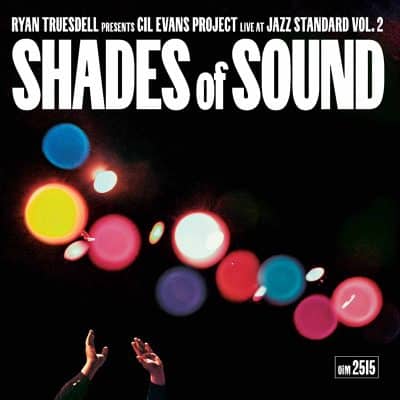Shades of Sound Gil Evans Project Live at Jazz Standard Vol. 2
 Shades of Sound
Shades of Sound
Gil Evans Project Live at Jazz Standard Vol. 2
Outside in Music
A few weeks ago, we published a review of the late Frank Kimbrough’s solo piano project, The Call. Now, multi-Grammy Award-winning producer Ryan Truesdell issues another posthumous album, showcasing Kimbrough’s artistry as the pianist for the Gil Evans project in performances dated May 13-18, 2014, during the band’s annual week-long engagement at the now-shuttered Jazz Standard in New York City. This represents the first time the band appears on vinyl and, along with Kimbrough, features these greats: drummer Lewis Nash, saxophonists Donny McCaslin and Steve Wilson, trombonist Ryan Keberle, and vocalist Wendy Gilles. This is a large orchestra of 22 pieces, including the vocalist. Truesdell and the band have two previous Grammy Award-nominated albums, with 2012’s Centennial and 2015’s Lines of Color. Incidentally, the band continues to perform and will honor Gil Evans’ 113th birthday with a week-long residency (May 13-17) at Birdland.
This live date consists of four never-before-recorded works – “Laughing at Life,” “It’s The Sentimental Thing to Do,” “I Had Someone Else Before I Had You,” and “Neetie’s Blues.” It also includes four well-known pieces from Evans’ earlier work – “Spoonful,” “The Ballad of the Sad Young Men,” “Barbara Song,” and “Buster’s Last Stand.” The album has the energy that only a live audience can create, and superb sound headed by James Farber’s engineering team. Evans is, of course, known for his colorful arrangements and is most often associated with Miles Davis. He was also a composer, represented here only by “Neetie’s Blues,” and “Buster’s Last Stand.” Yet, Truesdell’s arrangements reflect the kind of colorful harmonics that Evans was known for.
As you glean the liner notes written by Truesdell, he sets the stage in his last few lines – “And as a hush comes over the crowd when the first notes of “Spoonful” signal the start of the set, allow the myriad shades of Gil’s orchestrational sounds to welcome you to witness our musical snapshot in time, and bring Gil’s genius from the past, into the present once again.”
Willie Dixon likely never envisioned his tune “Spoonful” rendered by an orchestra of this size. Most of us probably still think of the blues-rock Cream version. Yet, in this practically 14-minute interpretation, we hear Kimbrough establish that familiar chord pattern followed by blistering solos from McCaslin on tenor, trumpeter Mat Jodrell, altoist Dave Pietro, and again, Kimbrough. This and “Barbara Song” first appeared on Evans’ 1964 album The Individualism of Gil Evans. Both have long become crowd favorites, and in the latter, McCaslin has the spotlight all to himself, allowing him to stretch out and engage the ensemble in vigorous dialogue with his phrases. These are representative of the soloist-driven approach that Evans was aiming for during the time of the ‘64 album.
Long considered one of Evans’ most haunting and evocative arrangements, “The Ballad of the Dad Young Men” was first recorded on Evans’1959 Great Jazz Standards. Kimbrough begins with an improvised solo leading into Keberle’s richly melancholic turn on trombone. As Truesdell reflects, he says, “it’s hard to hear these recordings without picturing Frank wedged into a corner of the stage behind a grand piano, listening intently and savoring the sounds and colors coalescing in that singular moment. But ultimately, it’s a gift to once again witness and preserve the memory of his immense talent, deep passion, wry humor, and adventurous spirit.”
“Laughing at Life,” originally writtenor vocalist Mary Lutes in 1957,’ is the first of three for vocalist Gilles, navigating a difficult arrangement that required lots of rehearsal time. Tenorist Tom Christensen and altoist Wison take brief solos on the breaks. Christensen shows his chops again on the previously unknown Evans’ original “Neetie’s Blues,” The title traces to a family nickname for Evans’ wife, Anita. Kimbrough digs deep into his blues bag and Nash gives a dirty, heavy, bluesy swing as the orchestra swells and recedes behind Christensen’s gutty solo. Gilles returns for “I Had Someone Else Before I Had You,” a tune that reveals Evans’ bebop and swing tendencies (he grew up in both eras). Gilles delivers the flirtatious vocal while Wilson briefly steps forward on clarinet and Marshall Gilkes on trombone. “It’s the Sentimental Thing to Do” features Gilles alone fronting the orchestra, which builds the kind of kaleidoscopic Evans’ colors behind her. Both of the latter pieces were first written during Evans’ tenure with the Claude Thornhill Orchestra in the early ‘40s. Also from the Thornhill period is the rousing closer, “Buster’s Last Stand,” featuring Kimbrough bluesy intro and feisty turns from trumpeter Greg Gisbert, a ferocious McCaslin, and a thunderous Nash.
Not only is this a fond remembrance of the beloved Frank Kimbrough, but it reminds us once again how Gil Evans had few peers in terms of orchestral arrangements. This runs the gamut from a sweet to a boisterous big band sound. Fortunately they kept the audience noise in, giving it that more energy.
- Jim Hynes
Buy Us a Cup of Coffee!
Join the movement in supporting Making a Scene, the premier independent resource for both emerging musicians and the dedicated fans who champion them.
We showcase this vibrant community that celebrates the raw talent and creative spirit driving the music industry forward. From insightful articles and in-depth interviews to exclusive content and insider tips, Making a Scene empowers artists to thrive and fans to discover their next favorite sound.
Together, let’s amplify the voices of independent musicians and forge unforgettable connections through the power of music
Make a one-time donation
Make a monthly donation
Make a yearly donation
Buy us a cup of Coffee!
Or enter a custom amount
Your contribution is appreciated.
Your contribution is appreciated.
Your contribution is appreciated.
DonateDonate monthlyDonate yearlyYou can donate directly through Paypal!
Subscribe to Our Newsletter
Order the New Book From Making a Scene
Breaking Chains – Navigating the Decentralized Music Industry
Breaking Chains is a groundbreaking guide for independent musicians ready to take control of their careers in the rapidly evolving world of decentralized music. From blockchain-powered royalties to NFTs, DAOs, and smart contracts, this book breaks down complex Web3 concepts into practical strategies that help artists earn more, connect directly with fans, and retain creative freedom. With real-world examples, platform recommendations, and step-by-step guidance, it empowers musicians to bypass traditional gatekeepers and build sustainable careers on their own terms.
More than just a tech manual, Breaking Chains explores the bigger picture—how decentralization can rebuild the music industry’s middle class, strengthen local economies, and transform fans into stakeholders in an artist’s journey. Whether you’re an emerging musician, a veteran indie artist, or a curious fan of the next music revolution, this book is your roadmap to the future of fair, transparent, and community-driven music.
Get your Limited Edition Signed and Numbered (Only 50 copies Available) Free Shipping Included
Discover more from Making A Scene!
Subscribe to get the latest posts sent to your email.









